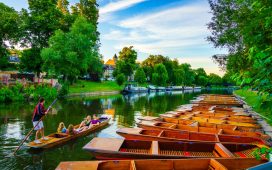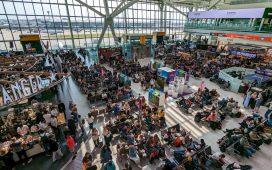Up on the hill we spy them: dark, imposing forms moving through the dense forest. It’s a group of bison wandering wild in Romania’s Făgăraș mountains. I stand silently with my guide Răzvan Dumitrache as the animals graze.
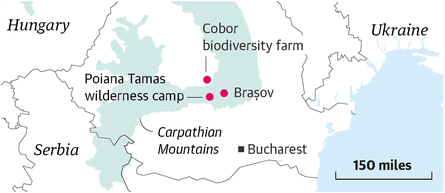
This area of Transylvania, at the southern edge of the Carpathian mountains, is among the wildest places in Europe. Brown bears, wolves and lynx roam the forested hillsides – and bison were recently reintroduced after a 200-year absence as part of the work of Foundation Conservation Carpathia. FCC’s ambitions are not small: it aims to create the continent’s largest forested national park. A 101,000- hectare (250,000-acre) wilderness reserve. A Yellowstone for Europe.
“The idea is for a park that will not only protect forests and wildlife, but also support local communities with ecotourism and nature-positive businesses,” says Răzvan.
Romania has more than 6m hectares of forest, of which a significant portion is still “virgin”, unfragmented areas with no human settlement, home to some of the few remaining sectors of old-growth forest in Europe. But illegal logging has cleared vast swathes of forest, and the destruction continues.
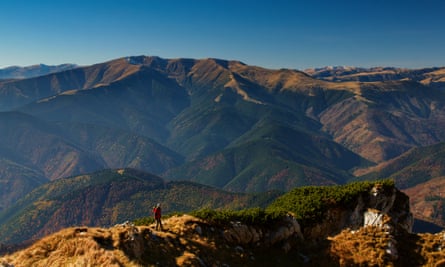
Since its inception in 2009, FCC’s biologist founders, Christoph and Barbara Promberger, and a team of philanthropists and conservationists, have been fundraising to purchase tracts of forests to stop logging – as well as buying areas to reforest. It’s a conservation model inspired by the Tompkins project in South America – with the goal being a vast park that’s “large enough to support significant numbers of large carnivores and to allow evolutionary processes to happen”.
So far, 26,900 hectares of forest and grassland have been bought and protected and more than 4m saplings planted. FCC rangers patrol 75,000 hectares, and this has led to a halt in logging in neighbouring forests too. In another innovative move, an FCC association has bought the hunting rights to an additional 78,000 hectares, to protect wildlife from trophy hunters.
Involving local communities, providing jobs and slowly bringing more visitors to the area is part of the plan. I’m here to sample the ecotourism offering, hiking to hides and campsites and watching wildlife. Before we walk to Poiana Tamas wilderness camp we stop at one of nine tree nurseries, where a mixture of native species are tended until they can be planted out. We visit the education centre too, where children learn about the importance of the landscape and how they can become involved in its protection.
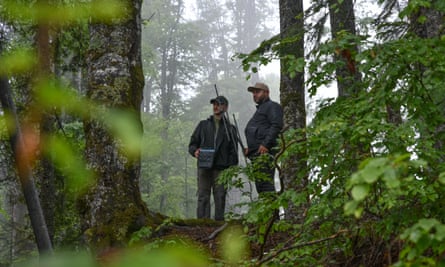
The hike is steep in parts as our path zigzags through forests. We see a viper, and pass some fresh (and huge) bear prints: gouge marks on a tree and overturned stones reveal its hunt for food. Knowing we could encounter wild animals around any corner is thrilling. The landscape seems to pulsate with energy. I’m torn between desperately hoping to see a bear close up and praying we won’t.
After a couple of hours we arrive at the campsite – the forest opens on to a meadow bursting with wildflowers. A restored mountain hut with 360-degree views is surrounded by tipi-style tents (with proper beds). The setting sun turns the limestone of the Piatra Craiului mountains a glowing pink.
The next day a combination of hiking and off-road driving takes us to Bunea hide at 1,200 metres. The wooden shelter overlooks a lake (arriving by electric boat is another option) and is surprisingly comfortable, with bunks, a double bedroom, a kitchen and even a proper shower. Huge, soundproofed windows make the most of the views.
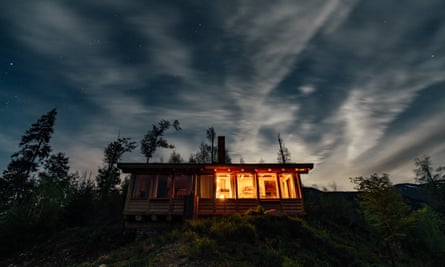
As night falls, I spy something moving into the clearing. A skittish young female brown bear stops to sniff the air, rolls in the grass and rubs against a tree. It’s mesmerising. We eat dinner of polenta and wild mushrooms staring out into the dark as if glued to a movie screen. A full moon illuminates the scene, and it’s not long before a large male wanders into view and snuffles around just metres away. From the guestbook it seems this is not unusual: excited scribbles tell of countless sightings of bear, wild boar and red deer. So I’m not surprised when I wake at dawn to see another female bear, pawing the ground in a search for grubs.
We wait until she’s been gone a while, then pick our way quietly through the forest, crossing a section of beautiful old beech, signs of recent animal movement evident all around. On a hillside across the river I spy a huge bare patch of land. It was illegally felled by a politician, Răzvan tells me, but FCC has now bought the land and replanting is under way.
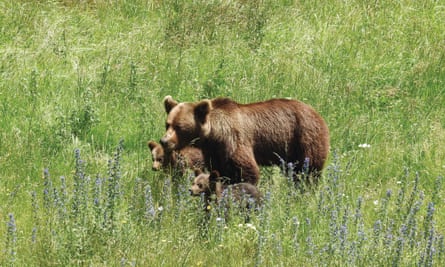
Today’s hike takes us up higher to another hide, Comisu, at 1,600 metres, with breathtaking views over the mountains. We leave our gear and climb higher still to the ridge of the Făgăraș mountains, the highest range in the southern Carpathians, before rain drives us back down. Drying out by the wood burner we watch as the night sky closes in, clear and star-filled, and an owl flies past, glowing like an angel in the moonlight.
Besides the hides, FCC’s tourism offering includes 500-hectare Cobor Biodiversity Farm, deep in the countryside in Ticușu Vechi, an hour and a half from Brașov. It’s a place frozen in time: horses and carts roll by and women work with scythes in the fields. The restored farmhouses sleep up to 23, and visitors can tour the farm where Hungarian grey cattle and a horse livery are part of a regenerative farming project. Carpathian shepherd dogs are bred here too, and given to local farmers and shepherds for protection against bears and wolves – the 10 pups on site are beyond cute. Village numbers at Cobor have dwindled to about 200, Răzvan tells me, but ecotourism jobs may entice more to stay.
My next stop is Nucșoara village, on the edge of the mountains close to Moldoveanu, the country’s highest peak. It’s home to an extraordinary ancient beech forest. The last partisan anti-communist communities hid here, the local history teacher Constantin Berevoianu says as we wander. Inspired by the local mayor, FCC has recently launched an “adopt a beech tree” campaign – funders can choose to have their stories told via the website and QR codes on the trees, and the money raised goes to protect the trees, improve infrastructure and attract more visitors.
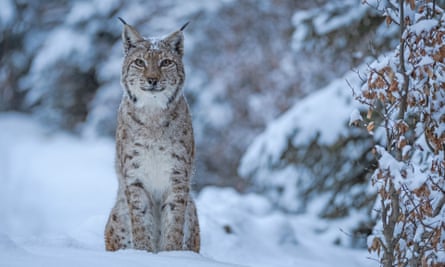
Engaging communities and showing that protecting nature can provide alternative revenue streams is crucial to the success of a new national park. Besides providing employment in roles from rangers to tree planters, FCC has created a “food hub” for small-scale local producers to sell their wares. Guests enjoy delicious cheeses, zacusca (an aubergine and pepper spread), jams and honey during their stay.
Regular events are also held to explain the work being done. Cobor Farm hosted its first festival this summer and my trip coincides with Făgăraș Fest, a free event now in its fourth year, held this time in Porumbacu de Sus, Sibiu. The mountain setting is spectacular and there are workshops, local food and great live music.
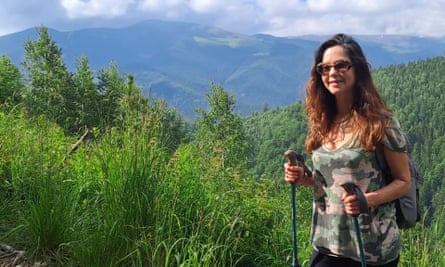
Tonight one of the stars is 80-year-old Silvia Dan from Nucșoara, who is singing as part of a show called Interbeing, created by the Brighton-based artist Nico de Transilvania. It’s an interesting blend of electronic music, traditional song and recordings of the sounds of nature. The resounding themes are of our interconnectedness with nature, the wisdom of the elders, and the importance of preserving these landscapes and traditions for future generations.
It’s a heartfelt message that resonates with FCC’s grand vision. A new park of this size may take decades to realise – but seeing the incredible beauty of what we risk losing and the passionate work being done to save it is quite something to behold.
The trip was provided by Foundation Conservation Carpathia. Accommodation at Cobor Farm starts at €46pp (activities extra). Prices for the hides at Comisu start at €173pp (first night, €115 additional nights), including guided hike, breakfast and dinner. Poiana Tamas wilderness camp is currently only available to groups. Three-day Complete Wildlife Experience packages cost from €345pp. For more information visit Travel Carpathia


